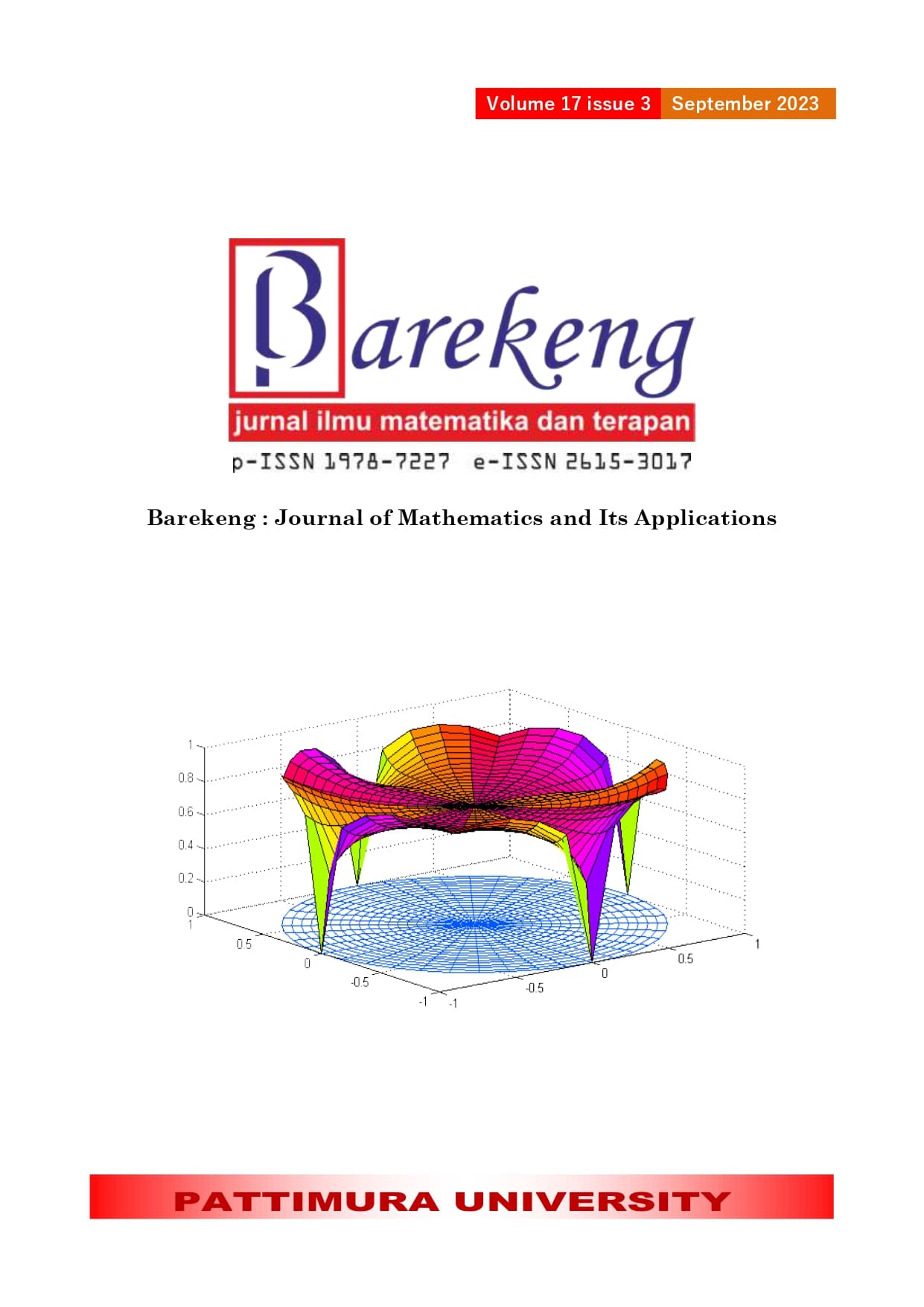ON RAINBOW ANTIMAGIC COLORING OF SNAIL GRAPH(S_n ), COCONUT ROOT GRAPH (Cr_(n,m) ), FAN STALK GRAPH (Kt_n ) AND THE LOTUS GRAPH(Lo_n )
Abstract
Rainbow antimagic coloring is a combination of antimagic labeling and rainbow coloring. Antimagic labeling is labeling of each vertex of the graph with a different label, so that each the sum of the vertices in the graph has a different weight. Rainbow coloring is part of the rainbow-connected edge coloring, where each graph has a rainbow path. A rainbow path in a graph is formed if two vertices on the graph do not have the same color. If the given color on each edge is different, for example in the function it is colored with a weight , it is called rainbow antimagic coloring. Rainbow antimagic coloring has a condition that every two vertices on a graph cannot have the same rainbow path. The minimum number of colors from rainbow antimagic coloring is called the rainbow antimagic connection number, denoted by In this study, we analyze the rainbow antimagic connection number of snail graph , coconut root graph , fan stalk graph and lotus graph .
Downloads
References
A. I. Kristiana, I. L. Mursyidah, Dafik, R. Adawiyah, and R. Alfarisi, “Local irregular vertex coloring of comb product by path graph and star graph,” Discret. Math. Algorithms Appl., vol. 2250148, 2022.
Slamin, Network Design: Graph Theory Approach. 2009.
N. Hartsfield and G. Ringel, Pearls in Graph Theory. 1990.
G. Chartrand and O. Oellermann, Applied and Algorithmic Graph Theory. 1993.
R. Prihandini, R. Adawiyah, A. Kristiana, Dafik, A. Fatahillah, and E. Albirri, “Some Families of Tree are Elegant,” Adv. Math. Sci. J., vol. 9, no. 12, 2020.
G. Chartrand, G. Johns, K. McKeon, and P. Zhang, “Rainbow connection in graphs,” Math . Bohemia., vol. 133, no. 1, pp. 85–98, 2008.
R. Alfarisi, R. Prihandini, R. Adawiyah, E. Albirri, and I. Agustin, “Graceful Chromatic Number of Unicyclic Graphs,” J. Phys. Conf. Ser., vol. 1306, no. 1, p. 012039, 2019.
Z. Al Jabbar, Dafik, R. Adawiyah, E. Albirri, and I. Agustin, “On rainbow antimagic coloring of some special graph,” J . Phys. Conf. Ser., vol. 1465, p. 012030, 2020.
B. Septory, M. Utoyo, Dafik, B. Sulistiyono, and I. Agustin, “On rainbow antimagic coloring of special graphs,” Phys.: Conf. Ser.J., vol. 1836, p. 012016, 2021.
B. Sulistiyono, Slamin, Dafik, I. Agustin, and R. Alfarisi, “On rainbow antimagic coloring of some graphs .,” J . Phys. Conf. Ser, vol. 1465, p. 012029, 2020.
H. Budi, Dafik, I. Tirta, I. Agustin, and A. Kristiana, “On rainbow antimagic coloring of graphs,” J . Phys. Conf. Ser., vol. 1832, p. 012016, 2021.
J. Joedo, Dafik, A. Kristiana, I. Agustin, and R. Nisviasari, “On the rainbow antimagic coloring of vertex amalgamation of graphs,” J . Phys. Conf. Ser., vol. 2157, p. 012014, 2022.
Dafik, F. Susanto, R. Alfarisi, B. Septory, I. Agustin, and M. Venkatachalam, “On rainbow antimagic coloring of graphs,” Adv. Math. Model. Appl., vol. 6, no. 3, pp. 278–291, 2021.
R. Adawiyah, R. M. Prihandini, E. R. Albirri, I. H. Agustin, and R. Alfarisi, “The local multiset dimension of unicyclic graph,” IOP Conf. Ser. Earth Environ. Sci., vol. 243, no. 1, p. 012075, 2019.
R. Adawiyah, I. Agustin, R. Prihandini, R. Alfarisi, and E. Albirri, “On the local multiset dimension of graph with homogenous pendant edges,” J. Phys. Conf. Ser., vol. 1538, no. 1, p. 012023, 2020.
Copyright (c) 2023 R Adawiyah, I I Makhfudloh, Dafik Dafik, RM Prihandini, AC Prihandoko

This work is licensed under a Creative Commons Attribution-ShareAlike 4.0 International License.
Authors who publish with this Journal agree to the following terms:
- Author retain copyright and grant the journal right of first publication with the work simultaneously licensed under a creative commons attribution license that allow others to share the work within an acknowledgement of the work’s authorship and initial publication of this journal.
- Authors are able to enter into separate, additional contractual arrangement for the non-exclusive distribution of the journal’s published version of the work (e.g. acknowledgement of its initial publication in this journal).
- Authors are permitted and encouraged to post their work online (e.g. in institutional repositories or on their websites) prior to and during the submission process, as it can lead to productive exchanges, as well as earlier and greater citation of published works.






1.gif)



